Microfiber curtains offer superior stain resistance, durability, and easy maintenance, making them ideal for high-traffic areas and homes with children or pets. Velvet curtains provide a luxurious texture and excellent insulation, enhancing room warmth and privacy while adding an elegant, sophisticated aesthetic.
Table of Comparison
| Feature | Microfiber | Velvet |
|---|---|---|
| Material Composition | Polyester or nylon synthetic fibers | Woven silk, cotton, or synthetic blend |
| Texture | Soft, smooth, suede-like finish | Luxurious, plush, dense pile |
| Durability | High abrasion resistance, easy to clean | Moderate, requires careful maintenance |
| Light Blocking | Moderate, semi-opaque | High, excellent for darkening rooms |
| Maintenance | Machine washable, stain resistant | Dry clean recommended, prone to crushing |
| Cost | Affordable, budget-friendly | Higher price, premium fabric |
| Use Case | Modern, casual interiors | Elegant, formal spaces |
Introduction: Choosing the Right Curtain Fabric
Selecting the right curtain fabric significantly impacts both the aesthetic appeal and functionality of a room. Microfiber offers a lightweight, durable option with excellent moisture resistance and easy maintenance, ideal for high-traffic areas or humid environments. Velvet provides a luxurious, thick texture that enhances insulation and light blocking, making it perfect for creating cozy, elegant spaces.
Microfiber Curtains: Features and Benefits
Microfiber curtains offer exceptional durability, stain resistance, and ease of maintenance, making them ideal for busy households and high-traffic areas. Their tightly woven fibers provide excellent light filtration and a soft, smooth texture that enhances room aesthetics while maintaining privacy. Manufactured from synthetic materials, microfiber curtains are also wrinkle-resistant and quick-drying, contributing to long-lasting performance and vibrant color retention.
Velvet Curtains: Luxurious Appeal and Advantages
Velvet curtains offer a luxurious appeal with their rich texture and deep, vibrant colors that enhance the elegance of any room. Their dense, soft fabric provides excellent insulation and light-blocking properties, making them ideal for energy efficiency and privacy. Velvet curtains are also durable and resistant to wear, ensuring long-lasting beauty and sophistication in home decor.
Appearance and Texture Comparison
Microfiber curtains exhibit a smooth, consistent surface with a matte finish, offering a modern and sleek appearance ideal for minimalist interiors. Velvet curtains feature a rich, luxurious texture with a subtle sheen that changes with light and touch, providing depth and elegance to traditional or opulent decor. The tactile difference is notable: microfiber is soft yet firm and lightweight, while velvet is plush, dense, and heavier, creating a sense of warmth and sophistication.
Durability: Microfiber vs Velvet
Microfiber curtains exhibit superior durability due to their tightly woven synthetic fibers, which resist wear, fading, and stains better than velvet. Velvet, often made from natural or blended fibers, tends to be more delicate and prone to crushing or matting with frequent use and exposure to sunlight. For long-term use in high-traffic areas, microfiber offers enhanced resilience and easier maintenance compared to plush but delicate velvet.
Maintenance and Cleaning: What to Expect
Microfiber curtains require minimal maintenance, as their synthetic fibers resist stains and dry quickly after cleaning, making them ideal for frequent washing with mild detergent. Velvet curtains demand more delicate care, often necessitating professional dry cleaning to preserve the fabric's texture and prevent crushing or color fading. Expect microfiber to offer easier spot cleaning and quicker drying times, while velvet requires gentle handling and specialized cleaning methods to maintain its luxurious appearance.
Light Control and Insulation Properties
Microfiber curtains offer superior light control by effectively blocking sunlight due to their tightly woven fabric, making them ideal for rooms requiring darkness and privacy. Velvet curtains excel in insulation properties, as their thick, dense pile traps heat and reduces drafts, enhancing energy efficiency in colder climates. Combining these materials can optimize both light blocking and thermal insulation, catering to diverse environmental needs.
Cost Differences and Budget Considerations
Microfiber curtains generally offer a more budget-friendly option compared to velvet, as microfiber fabric is less expensive to produce and purchase. Velvet curtains, known for their luxurious texture and heavier weight, usually come with higher costs due to premium materials and intricate manufacturing processes. When considering budget constraints, microfiber provides a cost-effective solution without sacrificing durability, while velvet is ideal for those willing to invest in a high-end aesthetic and enhanced insulation.
Ideal Room Settings for Each Fabric
Microfiber curtains excel in humidity-prone spaces like kitchens and bathrooms due to their moisture resistance and easy maintenance, making them ideal for modern, high-traffic rooms. Velvet curtains offer luxurious texture and warmth, perfect for living rooms and bedrooms where insulation and elegance are desired. Choose microfiber for durability and stain resistance in casual settings, while velvet suits formal interiors demanding opulence and sound absorption.
Conclusion: Which Curtain Fabric Suits Your Needs?
Microfiber curtains offer durability, stain resistance, and easy maintenance, making them ideal for high-traffic areas or homes with children and pets. Velvet curtains provide luxurious texture, excellent insulation, and light-blocking properties, perfect for creating a cozy, elegant ambiance in bedrooms or living rooms. Choose microfiber for practicality and low upkeep, while velvet suits those prioritizing rich aesthetics and warmth.

Infographic: Microfiber vs Velvet for Curtain
 azmater.com
azmater.com